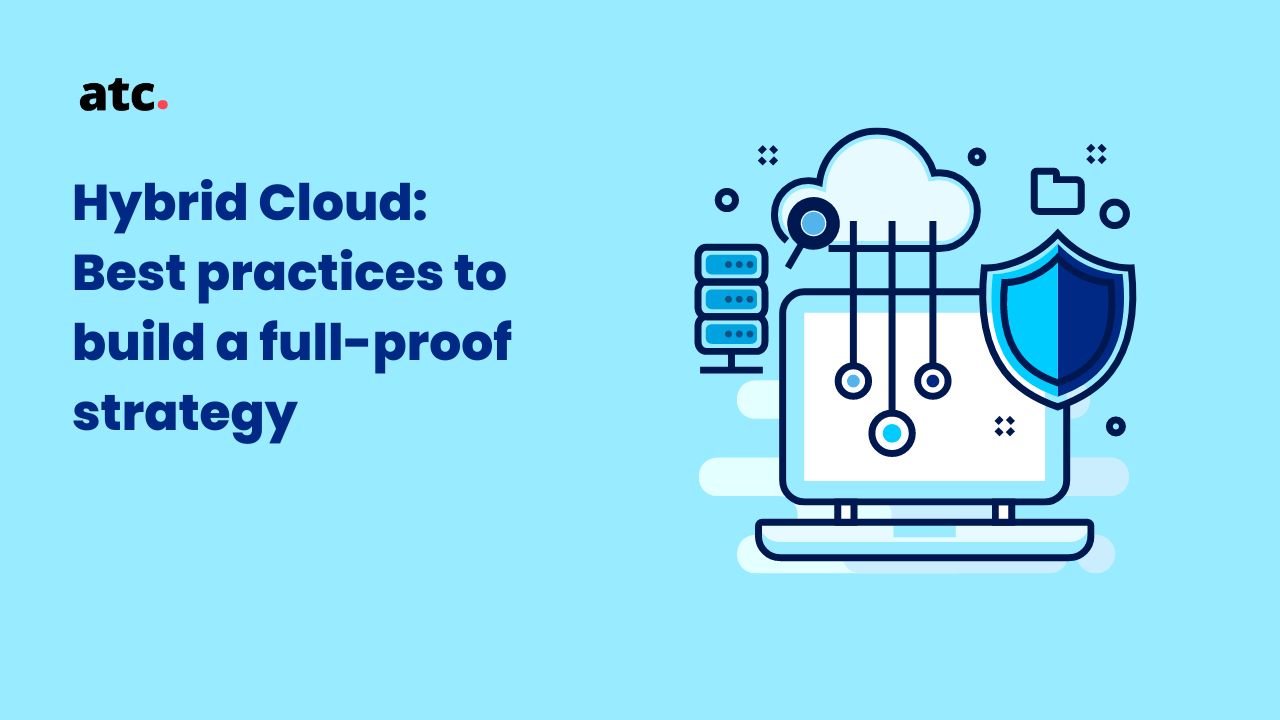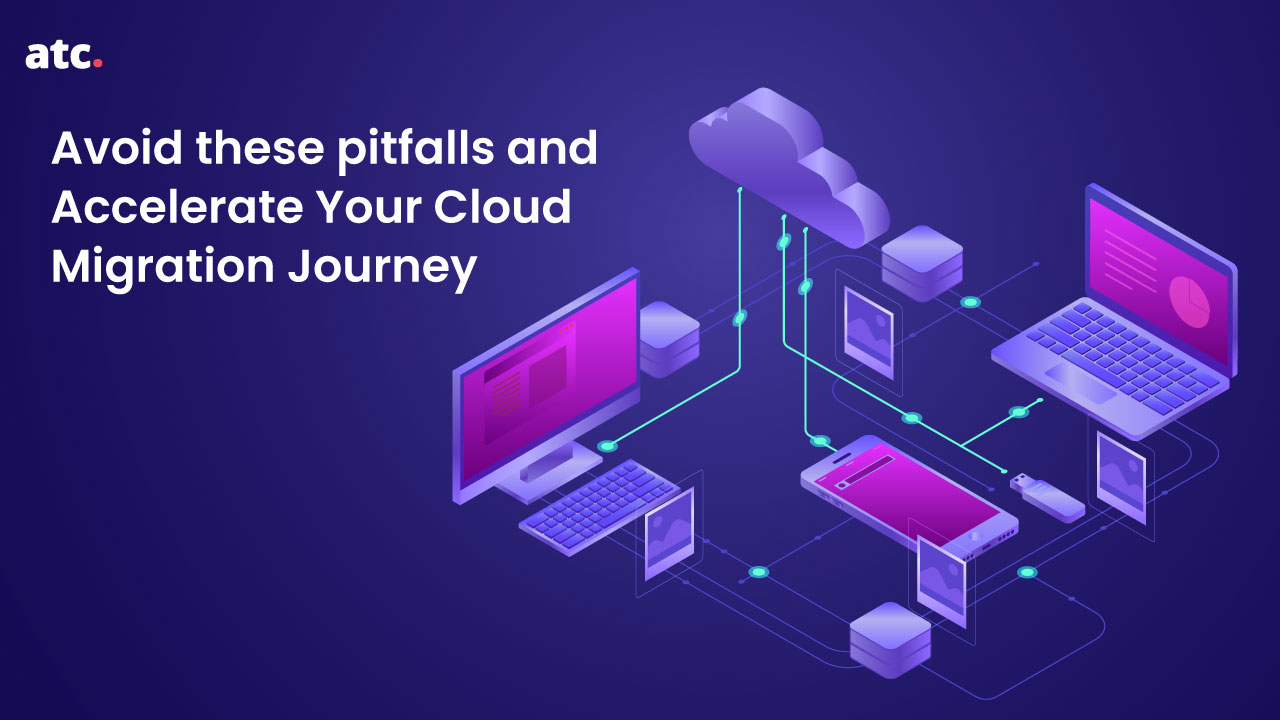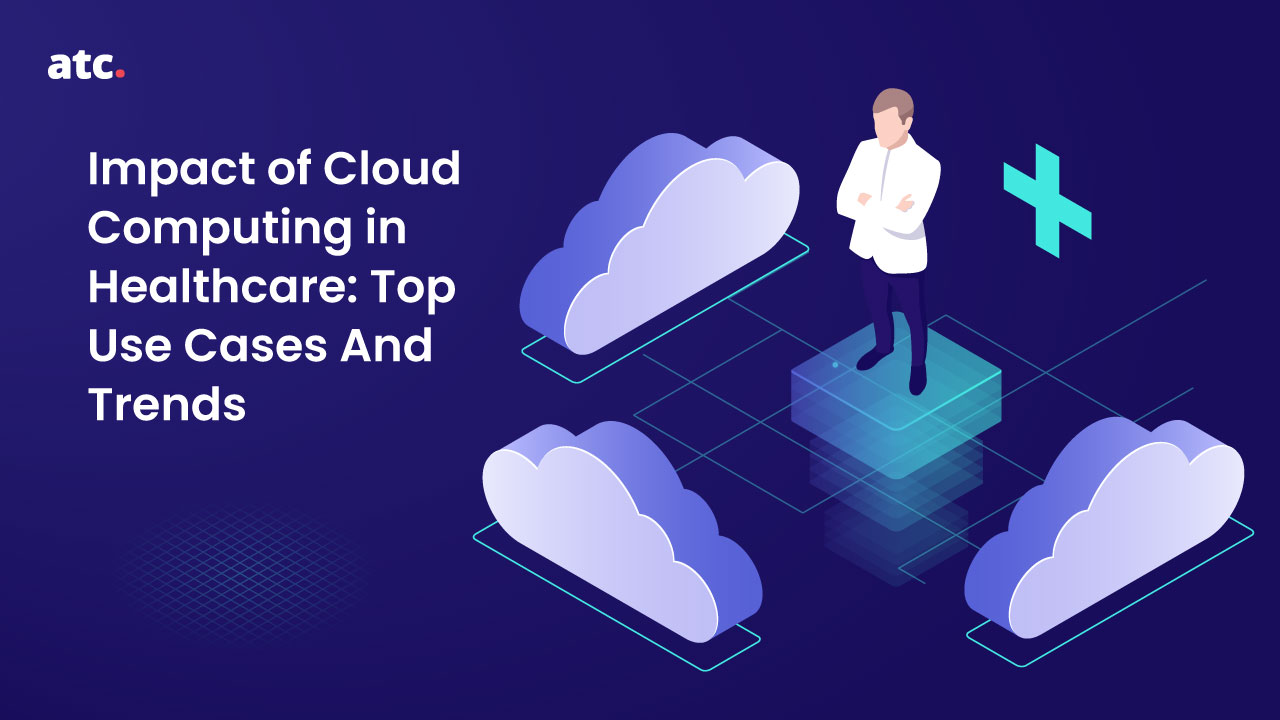Subscribe to the blog
Introduction
As businesses strive for innovation and agility, the cloud has become an increasingly popular option for IT transformation. But moving to the cloud is not a trivial task. It can be difficult to know where to start or what steps are necessary to achieve success. This blog post will explore the benefits of cloud transformation and outline some best practices to help you get started.
As per a report by Statista, as of 2022, over 60 percent of all corporate data is stored in the Cloud, and over 94% of businesses have been relying on ‘The Cloud’ for storing and managing resources with the objective of enhancing security, and efficiency while improving business agility.
What is Cloud?
Cloud is a real-world server network through which one can access data stored on servers by simply having an internet connection.
Today, “Cloud” is a vital online technology that is used all over the world, and the Cloud computing market has been on a rapid upward trajectory when it comes to Cloud adoption, infrastructure, spending, and development. Cloud technology has revolutionized the IT industry, providing a flexible and scalable way to store and access data. Organizations that undergo Cloud transformation typically see significant cost savings and increased revenues. This is due to the increased flexibility and innovation that Cloud computing provides. With Cloud computing, organizations can scale their IT infrastructure up or down as needed, only paying for the resources they use. This can lead to significant cost savings as businesses no longer need to maintain idle capacity.
| Did you know? If you're a fan of streaming media, then you've probably wondered at some point where all of your favorite shows and movies are stored. The answer is Cloud servers. Cloud servers are large, remote servers that store huge amounts of data. They are often used by businesses to store customer data, but they are also increasingly being used to store OTT streaming media. |
What is Cloud Transformation?
The oversimplified definition would be - “The process of moving your work data to the Cloud, including moving apps, data, software, or the entire IT infrastructure in line with your business goals, can be considered Cloud transformation.” Some of the benefits of Cloud transformation include improved organizational flexibility and scalability, faster time to market, and more effective data sharing and storage. Additionally, network security can be enhanced and made more robust with the aid of Cloud transformation.
However, the transformation must begin internally and changes need to be made on various levels since it influences every part of the business. Businesses believe that Cloud transformation is simply when they move their on-premise IT infrastructure to a Cloud service provider. This in fact is a misconception; in order to achieve success with Cloud transformation, organizations must first adapt their technological infrastructure, organizational culture, and business processes to make them Cloud-ready.
While a Cloud service/solution can help in resolving some technological issues, it is not the only element necessary for success. Even if all the resources are put into Cloud transformation, a lack of clarity and vision of the goal will result in the downfall of the initiative. Several organizations struggle with adapting to Cloud transformation because they don’t know where to begin.
Where to start when you’re thinking about Cloud Transformation - The Best Practices
Future Vision: Start with a Plan
The best-run businesses steadily plan and visualize their desired outcome in a clear and concise manner. It is no different in the case of successful Cloud transformation. If the company has not taken the time to thoroughly discuss, debate, agree upon, and document the strategy, it is unlikely that it will be able to utilize the full potential of Cloud transformation.
There are several things to consider when strategizing for Cloud transformation such as
- Defining your objectives, which could include anything from a company expansion to flexible spending or the need for increased agility.
- Setting a realistic timeline and focusing on how long will it take to complete the process of transformation.
- Determining which existing systems should remain on site or be retired and how they will impact the process.
- Evaluating the resources required for migration to the Cloud, and developing plans for tracking, governance, and billing.
- While making a plan might sound like a hassle, this first step is crucial for successfully adapting and integrating Cloud transformation in the business.
Set up a Cloud-based Business Office (CBO).
After planning and visualizing what the future of the company will look like after moving to the Cloud, the next important step is to create a Cloud Business Office (CBO). The Cloud Business Office ensures that the organization adapts to the use of Cloud across the business with effective monitoring. This is accomplished through everyone following a comprehensive decorum and taking positive steps. This will enable the workforce to adapt to Cloud computing widely, agreeing to receive extensive training while addressing any issues that may arise.
The CBO also manages the business risks associated with moving to the Cloud. The office is responsible for ensuring that security, dependability, availability, cost, and time to market are all considered when making decisions about Cloud adoption. Setting up a CBO is a way to ensure that the Cloud goals remain aligned with the business goals along with facilitating the change that comes with Cloud transformation.
Start Slowly and Rise Quickly
Moving to the Cloud is a big decision that might require a large-scale change in the organization. With this change new skills need to be learned, new processes must be organized and new ways of thinking need to be adopted, which can be stressful for everyone. This large-scale change can be disruptive and impact the organization negatively. In this case, it is wise to start small and build your way up to a larger scale.
To begin, incorporate Cloud governance into already-existing technology while monitoring on a small scale how it is impacting the workflow and the employees. If the workforce is functioning smoothly with the Cloud then move on to the next phase on a larger scale. A comprehensive step-by-step strategy will prove to be secure and effective for Cloud transformation.
Take Advantage of Cloud-Native Security Platforms
While moving all the important data of the company to the Cloud, stakeholders are always concerned regarding the security of the valuable data. To ensure the security of the data, it is a good idea to adopt a Cloud-native security platform. The term ‘Cloud-Native’ represents applications or tools that reside in the Cloud, which means the security tools will be part of the Cloud.
Cloud-native security platforms are more reliable than traditional security tools for various reasons. Cloud-native security platforms can be quickly deployed and updated to keep pace with the ever-changing threat landscape. In addition, they can offer increased visibility into Cloud activity, providing a more complete picture of an organization’s overall security posture. These security platforms are more cost-effective than traditional solutions, freeing up the budget for other critical initiatives.
Cloud-native security solutions have emerged as a popular choice for securing data in the cloud. These solutions offer a number of advantages over traditional security solutions, including the ability to move data to different locations within the cloud and the ability to back up and port data as needed. As a result, cloud-native security solutions are much more resilient than traditional security solutions and are better able to safeguard data against possible breaches. In addition, cloud-native security solutions are often less expensive than traditional security solutions, making them a more cost-effective option for businesses of all sizes. Since Cloud-native security solutions allow the movement of data to different locations within the Cloud, they are quite convenient to back up and port as and when required. This makes Cloud-native security platforms resilient in nature making and safeguards the data against possible data breaches.
Pick a service provider that fits best with your business needs
Numerous Cloud transformation service providers are available to help you assess, create, and manage your Cloud environment, but it can be difficult for organizations to identify the best Cloud solutions for their specific business needs and, more importantly, the best service provider to lead them through their Cloud transformation strategy. That’s why the organization should pick their vendor cautiously.
What to keep in mind when picking a vendor/service provider:
- Profile of Service Providers - The profiling process should be thorough and stringent. Shortlist profiles of providers based on their technical capabilities, including their data center infrastructure, security procedures, and disaster recovery plan. Profiling should also include considering the provider's business model, size, financial stability, and customer service record. It is also crucial to verify the provider's data and system security to make sure it's solid.
Consider providers with a successful track record and experience in working on technology similar to your company’s because that will make the migration process smoother.
- Services and Technology that Work Together - Make sure the platform and features of the platform are compatible with your current environment and support your Cloud goals. Find a provider that will fit the needs of your organization. The alignment of goals and expectations is crucial when it comes to Cloud transformation.
- Data Ownership - Look for service providers who let you decide where and how your data is processed, stored, and managed to avoid inconvenient ‘vendor lock-in’ situations. This can be inconvenient and may limit your options in the future. To avoid this, look for service providers who let you decide where and how your data is processed, stored, and managed. This way, you'll have more control over your data and won't be limited by a single vendor.
Customer dependence solely on a single Cloud provider's technology implementation is known as the vendor lock-in problem in Cloud computing. This happens when there are complications while switching vendors. The cost of switching is so expensive that the customer is essentially stuck using the original vendor and so is your valuable data.
- Minimal Downtime - Although downtimes are inevitable and you shouldn’t rule a provider out just because it openly publishes information about it. However, it’s important to know how often downtimes happen and how the provider solves such a situation. Verify provider’s processes, roles and responsibilities, tools, and disaster recovery provisions and assess how they might deal with downtime.
- Trustworthy Security - Ensure that the provider has a reliable level of data and system security. Look for a partner with a solid security and data sovereignty framework to make sure your data is in good hands. Ask specific, in-depth questions about your industry, special use cases, legal requirements, and other issues because the security of the company’s data is a top concern. Do not overlook assessing this crucial aspect of Cloud transformation.
- Dependable performance history - To ensure the provider is reliable and trustworthy, you should also take into account their financial situation, profile, and previous project history. Finding a Cloud provider with extensive subject knowledge and a track record of success is crucial.
- Trustworthy crisis management - The provider should be able to handle unexpected disasters with disaster recovery provisions, processes, and their ability to support your data preservation expectations.
- Potential to switch providers - Don't lock yourself into a single-partner framework because the market for Cloud services is still developing and has lots of contenders. The ability to quickly and easily switch from one platform to another is one benefit of Cloud-based services. You can also use platforms that connect to the services of alliance partners. An open policy and a balanced ecosystem of partners may not be practical, but they will give you the flexibility you need to continually differentiate and expand your company.
Make sure there will be a minimal amount of complications if you decide to switch service providers in the future according to what the business needs.
- Go with a dispersed platform - 'Data dispersion', just as it sounds, is a concept of geographically dispersing data for Cloud storage. Essentially, distributing the data among several storage mediums/servers and various Cloud service providers spread across geographical boundaries.
Data can be located closer to the end user by spreading out users' data across a network, which speeds up transfers, lowers network congestion, and lowers the chance of data loss.
Since there are so many providers available and their features initially appear to be similar, choosing the best one can be difficult. The best choice is always the result of a thorough evaluation of the minimum requirements and requirements for a particular business along with a comparison of the features, costs, reputation, security, and other aspects of the providers. Pick a provider best suited for your business to be able to reap the full benefits of Cloud transformation.
Benefits of Cloud Transformation
Streamlined Operational Efficiency
Several enterprises deploy their applications to the Cloud to increase operational efficiency and increase revenue. By migrating data and applications to the cloud, businesses can enjoy greater flexibility and scalability. In addition, cloud-based solutions are often easier to deploy and manage than on-premise systems. As a result, businesses that undergo cloud transformation can often enjoy significant improvements in efficiency and productivity.
Improved scalability
Cloud transformation is increasingly necessary for many businesses in order to maintain their competitiveness in the quickly changing market of today. Cloud-based companies stand out from their on-premises rivals by providing nearly instant scaling up to accommodate new priorities or projects. This prevents the organization from experiencing IT infrastructure upgrade delays of a few weeks to several months.
Cost-effectiveness
Cloud computing lowers the cost of version control and software maintenance. You can develop reusable software and application components with the help of a Cloud service provider, which eliminates the need for repetitive coding during version upgrades.
Along with this, the organization will not only save money but also time because all the information and resources are kept in one accessible location. Switching to the Cloud will save money on the hardware needed for IT infrastructure.
Companies save on server maintenance costs since a local server or an outdated setup needs continual maintenance, which raises the overall cost. When it comes to the Cloud, there is no such maintenance requirement. You don't have to spend money on on-site staff to manage systems, and you don't have to buy pricy systems to enable resources.
Enhanced customer accessibility and experience
Customers prefer access to data, services, and apps on the go, anywhere, at any time. Moving to the Cloud can help the business achieve this customer demand. Anyone would want a safe and reliable way to migrate data to the Cloud while they are on the go. That serves as the cornerstone for enhancing the client experience.
Increased Adaptability and Speed
You can scale up in response to rapid growth and pay for what you need, or due to unforeseen circumstances, if the number of clients decreases, you can scale down. Cloud computing's on-demand business models give an advantage in the allocation of resources and IT infrastructure.
Using Cloud transformation services, businesses can deploy apps quickly. With features like these, there is a decrease in workload, which frees up workers to focus on other important business needs. The entire purpose is to launch the applications and services more quickly than ever.
Stronger Data Security
When deciding to move to the Cloud, security becomes one of the top factors to take into account. Despite the fact that this is one of the drawbacks, the majority of Cloud providers address several security concerns by providing security tools. Good Cloud providers have solutions for blocking unauthorized traffic, protecting data from hacker attacks, password protection, and other issues. By selecting the best service provider, one can take advantage of the incomprehensible topic of Cloud security.
It is evident that using the Cloud is a trend that is expanding and will only get bigger as the Cloud's importance and advantages become more apparent.
Final Word
Cloud transformation can provide your business with a number of benefits, from increased efficiency and scalability to cost savings. By following some best practices, you can make the most of your cloud transformation and improve your bottom line. If you’re ready to start reaping the rewards of the cloud, contact us today. Our team will work with you to create a plan that fits your unique needs and helps you take full advantage of all the benefits cloud computing has to offer.




